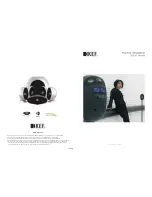
6
Outlaw Audio
Owner’s Manual
Notes on Speaker Placement
Notes on Speaker Placement
The following suggestions should be adhered to as closely as possible. While each
listening room imparts its own sonic compromises, these guidelines will help
you achieve the greatest performance form your Outlaw Loudspeaker system.
Placing your speakers at equal distances from the listening position, thus
creating an “equilateral” triangle will help create an optimal stereo imag-
ing environment. See diagram.
Soundstage is directly affected by “toe-in”. Pointing the loudspeakers directly
at the sweet spot creates the most accurate soundstage. See diagram.
These settings are:
Open air placement
The speaker is more than 24 inches away from all walls.
Single wall placement
The speaker is within 24 inches of a single wall.
Corner placement
The speaker is located within 24 inches of two walls.
The available settings allow you to tailor the behavior of your Outlaw Loud-
speakers for optimal performance under most listening room conditions.
Using the following guidelines, adjust each speaker according to its individual
environment. Keep in mind that this setting can and should vary by speaker
when necessary.
When the Outlaw Loudspeaker is no closer than 24 inches to any wall, the
Boundary switch should be set to “0”. If the Outlaw Loudspeaker is within
24 inches of a single wall, set the Boundary switch to “-2dB”. If the Outlaw
Loudspeaker is corner loaded (within 24 inches of two different walls), use the
“-4dB” boundary switch position.
High Frequency Switch
Each room imparts its own sonic signature to the signal that arrives at the
listening position. In rooms with minimal wall treatments, significant glass (i.e.
a large number of windows), hardwood or tile floors, the resulting sound may
have an overemphasized high frequency response. This is typically character-
ized as a slight edginess that may present itself in the form of listening fatigue.
In these listening environments we recommend using the “-2dB” position on
the Outlaw Loudspeaker’s High Frequency switch.
In overly dampened rooms with wall-to-wall carpets, extensive absorptive wall
coverings, acoustic panels, etc., you may find the high frequency response
lacking. This could be observed as a dull or less detailed performance. In these
listening environments, we recommend selecting the “+2dB” position on the
Outlaw Loudspeaker’s High Frequency switch.
Since most listening rooms are fairly well balanced, with a mix of dampening and
reflective surfaces the “0dB” position will be optimal for the majority of users.
External System Adjustments
Crossovers for use with powered subwoofers
The Outlaw Bookshelf Loudspeakers have a low frequency output that rivals
many larger speakers. As a standalone speaker they will provide a tight and
true-to-source reproduction of your audiophile grade recordings. But for those
seeking that last octave of audibility you may wish to consider the addition of
a powered subwoofer. Proper integration of sub and speaker begins with the
careful selection of the crossover.
Some receivers and processors supply a series of crossover options to integrate
your subwoofer. If you are using an Outlaw processor or receiver the optimal
setting is 60Hz.
For other systems, you will need to consider the Outlaw Loudspeaker’s +/-3dB
down point of 54Hz. Based upon the prevailing use of symmetrical fourth order
networks in receivers and processors, we suggest choosing the closest crossover
point provided by your system that is equal to or greater than 60Hz.
However, room anomalies may require that a speaker be toed further in
or out. Toeing a speaker out (adjusting the angle of the speaker outward
including straight forward) will widen your soundstage. The opposite will
occur when toeing a speaker in.
Proximity to walls and corners will increase low frequency output. When
placed too close this additional low frequency output may sound unnatural
or bloated. Whenever possible place your speakers no closer than two feet
to the nearest wall.
Setting the Outlaw Loudspeaker’s Controls
Boundary Compensation Switch
Depending on the proximity of your Outlaw Loudspeaker(s) to a wall or corner,
you may find that certain upper bass frequencies sound boomy, or excessively
hot. At these critical frequencies, this added energy manifests itself as “chesti-
ness,” particularly in male voices. To compensate for these compromised,
but often-necessary speaker placements, the Outlaw Bookshelf Loudspeakers
provide a custom Boundary Compensation Circuit.
While other manufacturers have recognized the importance of boundary
compensation circuitry, they often fall short in their implementation, opting
for a single “averaged” adjustment for all non-ideal speaker placements.
After carefully calculating the effects of wall proximity and corner loading
on the Outlaw Loudspeakers, we have integrated a no-compromise Boundary
Compensation Circuit that includes different settings for each of the major
speaker placement locations.


























